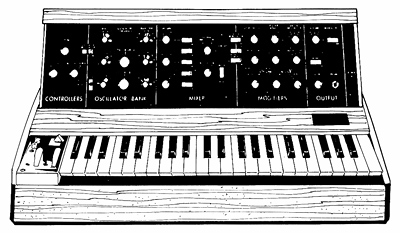|
.
1 | Music In The 20th Century
Music and Technology
Peter
Kun Frary
.
The music industry underwent a rapid revolution in the early twentieth century as new technologies for recording and distribution of music undermined traditional performance and publication. We'll examine these changes and the emerging technologies behind them.
Thomas Edison (1878) and cylinder phonograph | Library of Congress

 New Music Media New Music Media
Before the advent of audio recording, music was shared through music notation and live performance. Mechanical music boxes and player pianos existed, but these devices were expensive novelty items and not in widespread use.
 Phonograph Phonograph
A revolution in music distribution and consumption began with the invention of the phonograph in 1878. In 1904, the first commercial recordings of music appeared. The stage was now set for mass distribution and merchandising of music. The phonograph, a playback device for the LP or phonograph record, is still popular for music listening a century and a half after its invention.
 Radio Radio
Radio broadcasts of entertainment began in the United Kingdom in 1920. Radio stations programmed the latest phonograph records, increasing the popularity of musicians and phonograph technology.
Within a generation, radio and phonograph use skyrocketed, bringing music to remote corners of the Earth. The influence of these new methods of distribution was profound: creation of vast audiences and distribution networks, reduction of live performance opportunities for local musicians, declining sheet music sales, and rapid changes in musical styles.
Although radio is waning in the twenty-first century, mass consumption of music continues with web-based platforms such as streaming and downloads.
Vacuum Tube | Groove Tube GT-12AU7 from a 1995 Trace Elliot guitar amplifier. Tube design hasn't changed much since the 1950s. | ©Peter Kun Frary

 Audio Amplifiers Audio Amplifiers
Invention of the triode vacuum tube in 1907 by Lee De Forest is tied to the success of radio, audio recording, and performing. The vacuum tube is a device that controls electric current flow in a vacuum between electrodes. The triode added voltage gain control—amplification of the signal. Thus was born the audio amplifier, with prototypes appearing in 1912. Vacuum tubes were used in radio, television, and sound reinforcement until largely displaced by transistors during the 1960s. Vacuum tubes are still used in guitar amplifiers and audiophile gear.
Hirade TH90 Guitar | Amplifiers and microphones made it possible for soft instruments to be heard in large venues. | ©Peter Kun Frary

The significance of the audio amplifier is twofold for music:
- Small ensembles and soft instruments could perform in large venues.
- Recorded music could be played in any location with electricity, including automobiles, mass transit, homes and businesses.
One effect of amplifier use was the decline of large ensembles such as orchestras and brass bands, and subsequent reduction of music performance jobs. Now a concert or dance hall could be filled with sound from a handful of musicians. It was once common for radio stations to employ staff musicians; some even had orchestras on payroll. Radio stations and businesses gradually moved away from live musicians and used recorded music for convenience and reduced cost.
Genz Benz Shenandoah Guitar Amplifier | Photo courtesy Genz Benz

 Stylistic Changes Stylistic Changes
Audio amplifiers had a significant effect on musical style and technique, spawning singing and instrumental styles unimagined in the prior centuries of acoustic performance. There would be no shearing guitar solos or balancing of soft vocals with drums and brass instruments if it were not for microphones and amplifiers.
 Electrophones Electrophones
Invention and use of electrophones, i.e., electronic musical instruments, followed audio amplifiers. Electrophones produce sound using electronics: an electrical audio signal is output, processed, and amplified through an audio system.
Synthesizer | Many timbres are available on synthesizers | Dover Clip Art

Most electronic instruments are based on modified acoustic instruments, e.g., electric guitar and bass guitar. Others are purely electronic, such as computers, samplers, and synthesizers. Electronic musical instruments were not significant until the second half of the twentieth century and, indeed, have little role in classical, non-Western, and folk music. However, telephones are extremely important in recent popular music styles, computer games, and film.
Red Chevy | Automobiles, trains and airplanes made the world smaller and hastened the spread of culture | ©Peter Kun Frary

 Transportation Transportation
In earlier eras, musicians could only travel via foot, horse, or ship. The rise of rapid transportation—rail, highway, and air travel networks—opened new possibilities and made the world more accessible. People were freer than any time in history to choose where to live, travel, and how to spend leisure time. Musicians were able to quickly and relatively inexpensively tour, sharing musical influences across the globe. The Spanish guitar virtuoso, Andrés Segovia (1893-1987), toured every inhabited continent during the first half of the twentieth century, popularizing the guitar across the globe. The Japanese Imperial Court Orchestra in New York and a Hawaiian slack key festival in Seattle are just a few performances never thought possible before the twentieth century.
Rapid transportation and recording media did more than hasten Western cultural colonization of the world. Western artists were influenced by folk and popular music of Asia, Africa, and other non-Western societies. These influences echo in the music of Ravel, Stravinsky, and other early twentieth-century composers. Indeed, these influences are still heard today in the World Beat genre.
Hawaiian Air | Air travel made touring practical for musicians | ©Peter Frary

 Early Twentieth Century Styles Early Twentieth Century Styles
The twentieth century was an era of musical diversity. During the prior century, composers grew increasingly individualistic, stretching stylistic constraints to the breaking point. As the twentieth century dawned, this individualistic trend accelerated: musical styles multiplied and evolved rapidly, never again to conform to a single stylistic standard. In some cases, stylistic changes were so rapid and radical that audiences were confused and offended, forcing avant-garde artists to retreat into academia or, in the case of Russia, Germany, and China, flee to avoid persecution. Many fleeing artists were given asylum in the USA, enriching universities as professors and supplying Hollywood with soundtrack scores.
Due to amplifiers, audio recording, radio, and ease of travel, popular styles such as jazz, blues, country, etc., were heard outside regional venues, eventually displacing classical music as musical entertainment for the middle class.
Waves | Dockside reflections at Aloha Tower | ©Peter Kun Frary

Globalism and colonization by the West resulted in indelible changes to the musical tastes and traditions of the world. Traditional music of Asia, Africa, the Pacific, etc., began to change—sometimes disappearing but in other cases evolving into new forms mixed with Western styles. Indeed, some of the most popular musical styles evolved from an intermingling of Western and Non-Western music: salsa, K-Pop, jazz, kī hōʻalu, kayokyoku, and many others.
Our final topics of Impressionism, blues and jazz, Gershwin, Ives, kī hōʻalu, and the 'ukulele are samples from the tip of the twentieth-century iceberg. The mammoth diversity of twentieth-century music is beyond the scope of this course. However, separate UH System courses on popular music, jazz, K-Pop, Reggae, and others are available for further study.
Vocabulary
phonograph, phonograph record, radio broadcasting, vacuum tube, triode vacuum tube, audio amplifier
©Copyright 2018-25 by Peter Kun Frary | All Rights Reserved
|



